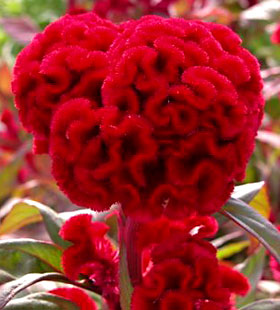Celosia argentea

Propagation:
- Celosia are in the same botanical family as amaranth, and share some of the same characteristics: quick germination and rapid early growth.
- Early crops are generally sowed in seedboxes and transplanted. Do not cover the seed, as it needs light for germination.
- When soils warm up in the tunnel, direct seeding is effective.
- Seed boxes of 128- to 200-cell count are most effective for this crop.
Growing:
- Growth duration in the seedbox is 3 to 5 weeks.
- Spacing in the high tunnel of 9 x 9 in. has proven adequate in 4 ft. beds, allowing growth of sideshoots after the main stem has been harvested.
- First harvest occurs mid-July after a late May transplanting in Zone 5 climate, and can last as long as 2 months.
- For single harvests of single stems, a 6 x 6 in. spacing is recommended.

Varieties:
- Varieties are classified into three major groups:
- Cristata Group (cockscomb)
- Plumosa Group (plume type)
- Spicata Group (has smaller, more slender plumes)
- The cockscomb type features brilliant colors, and contorted heads that resemble brains. The stems are frequently thick, and some varieties such as the Bombay series produce no side shoots or branches.
- Plume type celosia can produce a high number of side shoots and are very productive.
- Cramer selections of both Cristata and Plumosa types have wide adaptation in the Northeastern U.S.
Postharvest Handling:
- Expect the flowers to last a week in water at room temperature.
- Cristata types tend to be longer lived than Plumosa, and leaf longevity is shorter than that of the flowers, so defoliation may help prolong vase life.
For more information, see: Armitage, A.M. and J.M. Laushman. 2003. Specialty Cut Flowers, 2nd Edition. Timber Press, 586 pp. Available through ASCFG.


